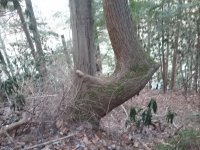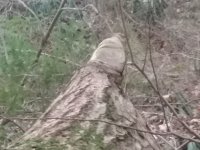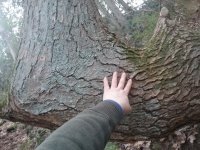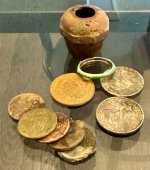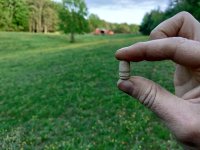You are using an out of date browser. It may not display this or other websites correctly.
You should upgrade or use an alternative browser.
You should upgrade or use an alternative browser.
Swift Silver??
- Thread starter DSL
- Start date
KY Hiker
Bronze Member
- Oct 28, 2014
- 1,537
- 3,220
- Detector(s) used
- Whites
- Primary Interest:
- All Treasure Hunting
Nice, it has some age, I don't have an eye for such things. Couldn't that be from another downed tree laying in that notch when it was young?
Brushy Bandit
Full Member
Nice, it has some age, I don't have an eye for such things. Couldn't that be from another downed tree laying in that notch when it was young?
Could be, from what I've read tho, they make the nubs grow so profound by putting charcoal in them. I mean the nubs at the nose and tail.
KY Hiker
Bronze Member
- Oct 28, 2014
- 1,537
- 3,220
- Detector(s) used
- Whites
- Primary Interest:
- All Treasure Hunting
Could be, from what I've read tho, they make the nubs grow so profound by putting charcoal in them. I mean the nubs at the nose and tail.
Looks like you have found one then! I have seen similar looking trees before, I don't recall the nubs though. Like I said, I don't have an eye for such things, or didn't know what I was looking at.
Was this in the Caney Creek area of the waybill?
Brushy Bandit
Full Member
Looks like you have found one then! I have seen similar looking trees before, I don't recall the nubs though. Like I said, I don't have an eye for such things, or didn't know what I was looking at.
Was this in the Caney Creek area of the waybill?
Yeah it's close to line of rocks. You can see the river in the background of the picture, it's not pointing at water
hmmm: my my another frog leg. there's one on war fork that has 3 nubs on it, points to wind cave and a mine close to wind cave. never found what the other was pointing to. Spanish. has for this one, with all the bends in that part of the river, my first guess would be the bend and straight run to line of rocks. notice flat area on under side on bend of tree. stops at small nub. if you place google earth map next to tree photo, it shows same cut in river where Indian and snake carving are. straight part of tree points to line of rock. large nub points towards bell shaped island on that small drain across from Indian carving, just north east. place small nub at mouth of drain that indian carving is, something up that drain or at bell. just a guess, so many ways to look at this.
KY Hiker
Bronze Member
- Oct 28, 2014
- 1,537
- 3,220
- Detector(s) used
- Whites
- Primary Interest:
- All Treasure Hunting
hmmm: my my another frog leg. there's one on war fork that has 3 nubs on it, points to wind cave and a mine close to wind cave. never found what the other was pointing to. Spanish. has for this one, with all the bends in that part of the river, my first guess would be the bend and straight run to line of rocks. notice flat area on under side on bend of tree. stops at small nub. if you place google earth map next to tree photo, it shows same cut in river where Indian and snake carving are. straight part of tree points to line of rock. large nub points towards bell shaped island on that small drain across from Indian carving, just north east. place small nub at mouth of drain that indian carving is, something up that drain or at bell. just a guess, so many ways to look at this.
Boomer, are you saying these were made by the Spanish rather than Indian? Or just that the one on War Fork points to Spanish mines? I have come across similar tree shapes while hiking, typically near streams (within 100ft). As I stated in an earlier post, I never looked at them as anything other than naturally formed because I didn't have an eye for looking for them. I wonder if there are any on lower Devil's Creek...?
Last edited:
Hiker: I never payed much notice to tree sculptures until I got a set of Spanish maps from new Orleans back in 1972. on 2 maps it showed this -s--->+ after 3 months I started looking in signs and symbols of the Indians than moved on to French, English and Spanish. after 2 months, nothing. this blew me away, in the hallway was a small framed letter with symbols that I saved. an old man from Lexington ky. sent me a letter and a hand drawn set of symbols that he collected around Kentucky of Spanish and French carvings. here was what I needed and it was in front of me the whole time. go along the creek to a set of rocks or a tree formed similar to an S ---- dots mean follow creek > down stream to a drain + look all round for next sign. that's when I found another tree shaped like a frogs leg pointing to wind cave and a mine on past wind cave. at the mine, found a Spanish crown word flippa or eli pa carved and a Spanish cross. Indians use trees and rocks to mark trails and good camp sites. French/Spanish marked to show something important. English marked trails and to throw people off the correct trail. I learned to keep an eye out. has for devils creek, it was used by the people of Boonsboro for salt making, that's were the iron kettles were found. they had 3 stone sheds there and several workers. ed
KY Hiker
Bronze Member
- Oct 28, 2014
- 1,537
- 3,220
- Detector(s) used
- Whites
- Primary Interest:
- All Treasure Hunting
OK I think I follow. So this is a different tree sign than what I had in mind. Seem to recall reading that Indians would bend saplings over almost to the ground along paths in the direction of their travel and tie them off. After several years being bent and tied off the tree would begin to grow vertical again. The tree would always have that curve in it to mark the path as long as the tree was alive.
I would assume by seeing these near streams would make sense, Indian traces followed Buffalo and deer traces which typically followed creeks and streams until a shallow or narrow place could be found to cross.
I would assume by seeing these near streams would make sense, Indian traces followed Buffalo and deer traces which typically followed creeks and streams until a shallow or narrow place could be found to cross.
Last edited:
Curtis
Hero Member
I do see the point about cabin fires, but IF the area is near the intersection of Little Caney and the Little Sandy, then its highly unlikely there were many cabins there...its similar to a mini grand canyon there and unlikely place for a home.
- Jun 1, 2012
- 5,036
- 7,168
- Detector(s) used
- Garrett ADS-7X, Fisher Two Box M-Scope, Mother Lode Locator, Dowsing Model 20 Electroscope, White's TM808, White's TM900, Inground Scanners
- Primary Interest:
- All Treasure Hunting
Isn't that the same area that John Filson went missing after meeting his partners near Cincinnati, Ohio or Lowlantsville.
KY Hiker
Bronze Member
- Oct 28, 2014
- 1,537
- 3,220
- Detector(s) used
- Whites
- Primary Interest:
- All Treasure Hunting
I do see the point about cabin fires, but IF the area is near the intersection of Little Caney and the Little Sandy, then its highly unlikely there were many cabins there...its similar to a mini grand canyon there and unlikely place for a home.
Did I miss something? Who mentioned cabin fires? LOL
KY Hiker
Bronze Member
- Oct 28, 2014
- 1,537
- 3,220
- Detector(s) used
- Whites
- Primary Interest:
- All Treasure Hunting
Isn't that the same area that John Filson went missing after meeting his partners near Cincinnati, Ohio or Lowlantsville.
The report of that I read said it happened in Ohio. I forget the name of the creek. But I would imagine he was coming back to Lexington or Louisville, either way, it would be South or SW from the Cinci area and not ESE towards Caney.
Last edited:
- Jun 1, 2012
- 5,036
- 7,168
- Detector(s) used
- Garrett ADS-7X, Fisher Two Box M-Scope, Mother Lode Locator, Dowsing Model 20 Electroscope, White's TM808, White's TM900, Inground Scanners
- Primary Interest:
- All Treasure Hunting
Strangest thing I ever saw was in the mountains of southern West Virginia. Before I knew what silver or gold was in it's natural surroundings. I was out ginseng hunting. I had entered one of the worst fire scoulds on the south side of the mountain as all "seng" hunters know that is the driest and hottest side of the mountain during the day time. But anyway, the weather was scorching that day. As I was beating and half tearing my clothes off on the rough and tough underbrush while crossing under a cliff, I noticed something about three quarters of an inch in diameter and some over eighteen inches long, they looked like candles. I picked one up, but they were lighter than what silver should have weighed, so I threw it back down. Is there anyway, this could have been silver? The metal had melted and ran out of the cliff rocks and as I said it was not all that heavy. Could it have been silver?
KY Hiker
Bronze Member
- Oct 28, 2014
- 1,537
- 3,220
- Detector(s) used
- Whites
- Primary Interest:
- All Treasure Hunting
Here is a list of some metals and their melting points. Granted, the melting points change if they are alloys.
Melting Points of Various Metals
Metal Fahrenheit (f)
Gold 1945
Lead 621
Magnesium 1204
Nickel 2646
Silver 1761
Steel 2500
Tungsten 6150
Wrought Iron 2700
Zinc 787
most of your standard forest/wood fires stay at or below 1100 F unless they are 'pumped' with air. Wind, bellows whatever. Since you said it was not as heavy as you thought it should be for Silver it probably was Zinc or, if hot enough, maybe Magnesium.
What you described sounds to me like Pine Sap candles, long flows of pine sap coming from trees whose base it burning and the sap boils out onto the trunk of the tree. When they cool they later fall to the ground.
Melting Points of Various Metals
Metal Fahrenheit (f)
Gold 1945
Lead 621
Magnesium 1204
Nickel 2646
Silver 1761
Steel 2500
Tungsten 6150
Wrought Iron 2700
Zinc 787
most of your standard forest/wood fires stay at or below 1100 F unless they are 'pumped' with air. Wind, bellows whatever. Since you said it was not as heavy as you thought it should be for Silver it probably was Zinc or, if hot enough, maybe Magnesium.
What you described sounds to me like Pine Sap candles, long flows of pine sap coming from trees whose base it burning and the sap boils out onto the trunk of the tree. When they cool they later fall to the ground.
Last edited:
- Jun 1, 2012
- 5,036
- 7,168
- Detector(s) used
- Garrett ADS-7X, Fisher Two Box M-Scope, Mother Lode Locator, Dowsing Model 20 Electroscope, White's TM808, White's TM900, Inground Scanners
- Primary Interest:
- All Treasure Hunting
No this were white metal but it was light like aluminum instead of silver. Could it been an alum silicate?
KY Hiker
Bronze Member
- Oct 28, 2014
- 1,537
- 3,220
- Detector(s) used
- Whites
- Primary Interest:
- All Treasure Hunting
<<shrug>> I don't know....
Rebel - KGC
Gold Member
- Jun 15, 2007
- 21,680
- 14,739
Sounds like LEAD... melts easy (over a campfire); dull Silver color...?Strangest thing I ever saw was in the mountains of southern West Virginia. Before I knew what silver or gold was in it's natural surroundings. I was out ginseng hunting. I had entered one of the worst fire scoulds on the south side of the mountain as all "seng" hunters know that is the driest and hottest side of the mountain during the day time. But anyway, the weather was scorching that day. As I was beating and half tearing my clothes off on the rough and tough underbrush while crossing under a cliff, I noticed something about three quarters of an inch in diameter and some over eighteen inches long, they looked like candles. I picked one up, but they were lighter than what silver should have weighed, so I threw it back down. Is there anyway, this could have been silver? The metal had melted and ran out of the cliff rocks and as I said it was not all that heavy. Could it have been silver?
KY Hiker
Bronze Member
- Oct 28, 2014
- 1,537
- 3,220
- Detector(s) used
- Whites
- Primary Interest:
- All Treasure Hunting
Sounds like LEAD... melts easy (over a campfire); dull Silver color...?
Yea but Lead is dense and heavy like Gold, it would not seem light in weight like Aluminum. Maybe is was aluminum...melted cans/trash in the woods?
Top Member Reactions
-
 2303
2303 -
 1110
1110 -
 1034
1034 -
 905
905 -
 850
850 -
 763
763 -
 758
758 -
 737
737 -
 606
606 -
 508
508 -
 490
490 -
 477
477 -
 447
447 -
 420
420 -
 403
403 -
O
401
-
 399
399 -
 394
394 -
 384
384 -
 376
376
Users who are viewing this thread
Total: 2 (members: 0, guests: 2)
